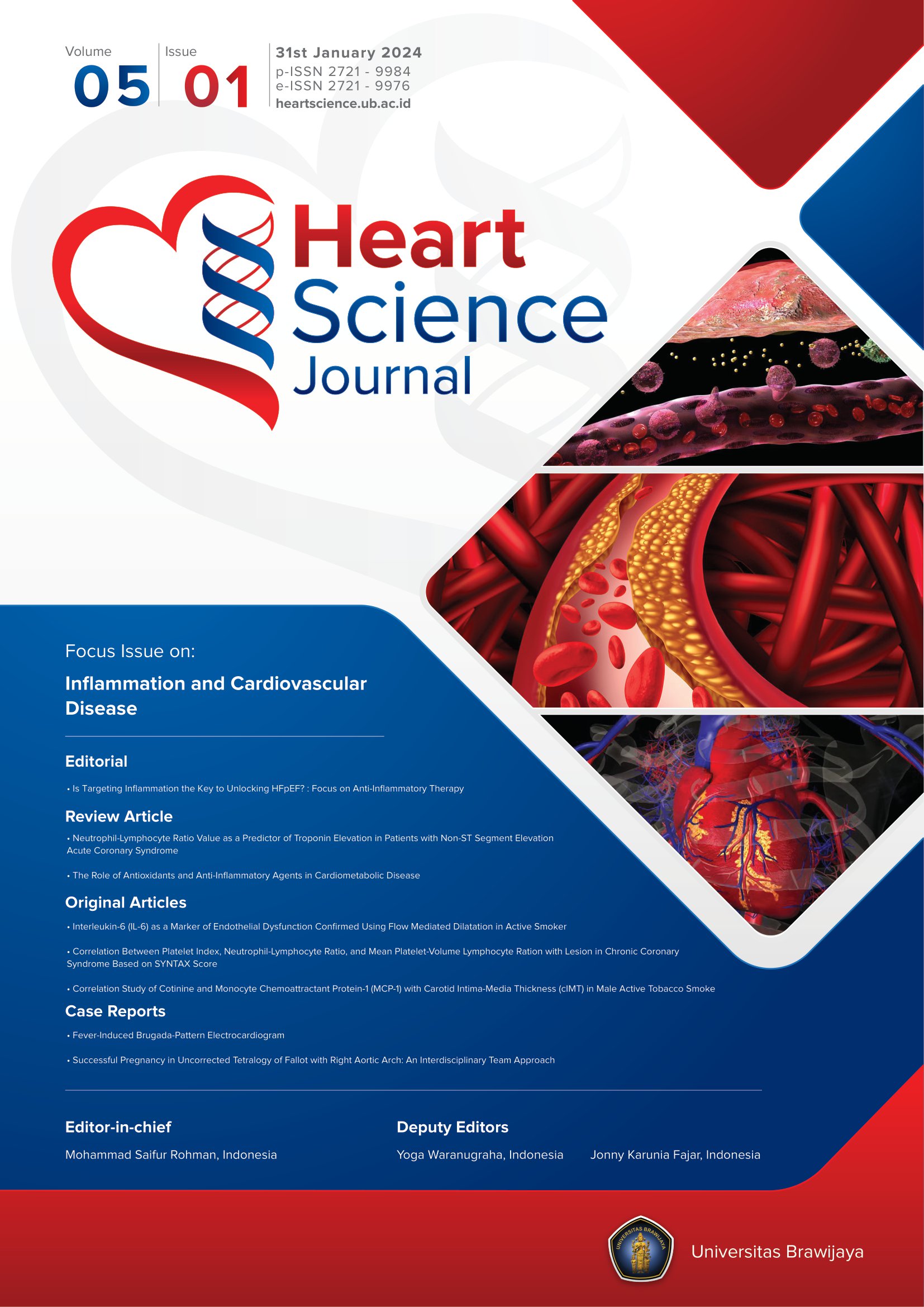Improving Quality of Life with Percutaneous Coronary Intervention in Chronic Coronary Syndrome Patients with SYNTAX Score of More than 22
Abstract
Background: The benefit of PCI to improve quality of life (QoL) in chronic coronary syndrome (CCS) is still unclear
Objectives: This study aimed to assess the benefit of percutaneous coronary intervention (PCI) in improving QoL among CCS patients receiving OMT.
Methods: We conducted a retrospective cohort study. CCS patients who underwent coronary angiography (CAG) and/or PCI were grouped into OMT plus PCI and OMT groups. The SYNTAX score was used to assess the complexity and severity of coronary artery lesions. The outcome measured was QoL assessed using Seattle Angina Questionnaire (SAQ) and rehospitalization.
Results: A total of 57 patients in the OMT plus PCI group and 49 patients in the OMT group were included. The percentage of patients with good QoL was higher in the OMT plus PCI group than OMT only group (64.5% vs. 35.5%; p = 0.007). The OMT plus PCI group revealed a better activities of daily living (85.11 ± 12.46 vs. 12.46 ± 21.87; p = 0.014) and angina stability (84.32 ± 23.63 vs. 71.81 ± 27.89; p = 0.014) than OMT group. Among patients with SYNTAX scores of more than 22, achievement of good QoL was greater in the OMT plus PCI group than the OMT group (80.8% vs. 45.5%; p = 0.025).
Conclusion: PCI improved the QoL in CCS patients treated with OMT. Second, OMT plus PCI improves physical limitation and angina stability. For patients with a SYNTAX score of more than 22, OMT plus PCI was correlated with good QoL achievementKeywords
Full Text:
PDFReferences
Knuuti J, Wijns W, Saraste A, et al. 2019 ESC Guidelines for the diagnosis and management of chronic coronary syndromes. Eur Heart J. 2020;41(3):407-477. doi:10.1093/eurheartj/ehz425
Ford TJ, Corcoran D, Berry C. Stable coronary syndromes: pathophysiology, diagnostic advances and therapeutic need. Heart. 2018;104(4):284-292. doi:10.1136/heartjnl-2017-311446
Virani SS, Alonso A, Benjamin EJ, et al. Heart Disease and Stroke Statistics—2020 Update: A Report from the American Heart Association. Circulation. 2020;141(9):e139-e596. doi:10.1161/CIR.0000000000000757
Hussain MA, Al Mamun A, Peters SA, Woodward M, Huxley RR. The Burden of Cardiovascular Disease Attributable to Major Modifiable Risk Factors in Indonesia. J Epidemiol. 2016;26(10):515-521. doi:10.2188/jea.JE20150178
Fihn SD, Gardin JM, Abrams J, et al. 2012 ACCF/AHA/ACP/AATS/PCNA/SCAI/STS Guideline for the Diagnosis and Management of Patients With Stable Ischemic Heart Disease. J Am Coll Cardiol. 2012;60(24):e44-e164. doi:10.1016/j.jacc.2012.07.013
Neumann F-J, Sousa-Uva M, Ahlsson A, et al. 2018 ESC/EACTS Guidelines on myocardial revascularization. Eur Heart J. 2019;40(2):87-165. doi:10.1093/eurheartj/ehy394
Sianos G, Morel M-A, Kappetein AP, et al. The SYNTAX Score: an angiographic tool grading the complexity of coronary artery disease. EuroIntervention. 2005;1(2):219-227.
Franzone A, Taniwaki M, Rigamonti F, et al. Angiographic complexity of coronary artery disease according to SYNTAX score and clinical outcomes after revascularisation with newer-generation drug-eluting stents: a substudy of the BIOSCIENCE trial. EuroIntervention. 2016;12(5):e595-e604. doi:10.4244/EIJV12I5A99
Généreux P, Columbia University Medical Centre and The Cardiovascular Research Foundation, 111 East 59th St, 11th Floor, New York, NY 10022, US. E: pg2295@columbia.edu; Hôpital du Sacré-Coeur de Montréal, Université de Montréal, Montréal, Palmerini T, et al. A Guide to Calculating SYNTAX Score. Interv Cardiol Rev. 2012;7(1):21-23. doi:10.15420/icr.2012.7.1.21
Yadav M, Palmerini T, Caixeta A, et al. Prediction of Coronary Risk by SYNTAX and Derived Scores. J Am Coll Cardiol. 2013;62(14):1219-1230. doi:10.1016/j.jacc.2013.06.047
Spertus JA, Winder JA, Dewhurst TA, et al. Development and evaluation of the Seattle Angina questionnaire: A new functional status measure for coronary artery disease. J Am Coll Cardiol. 1995;25(2):333-341. doi:10.1016/0735-1097(94)00397-9
Ambrose JA, Singh M. Pathophysiology of coronary artery disease leading to acute coronary syndromes. F1000Prime Rep. 2015;7(8):1-5. doi:10.12703/P7-08
Bonello L, De Labriolle A, Lemesle G, et al. Intravascular ultrasound-guided percutaneous coronary interventions in contemporary practice. Arch Cardiovasc Dis. 2009;102(2):143-151. doi:10.1016/j.acvd.2008.11.002
Prati F, Regar E, Mintz GS, et al. Expert review document on methodology, terminology, and clinical applications of optical coherence tomography: physical principles, methodology of image acquisition, and clinical application for assessment of coronary arteries and atherosclerosis. Eur Heart J. 2010;31(4):401-415. doi:10.1093/eurheartj/ehp433
Spaan JAE, Piek JJ, Hoffman JIE, Siebes M. Physiological Basis of Clinically Used Coronary Hemodynamic Indices. Circulation. 2006;113(3):446-455. doi:10.1161/CIRCULATIONAHA.105.587196
Simoons ML, Windecker S. Chronic stable coronary artery disease: drugs vs. revascularization. Eur Heart J. 2010;31(5):530-541. doi:10.1093/eurheartj/ehp605
Weintraub WS, Zhang Z, Lewis C, Kaufman S, Boden WE. Effect of PCI on Quality of Life in Patients with Stable Coronary Disease. N Engl J Med. 2008;359(7):677-687. doi:10.1056/NEJMoa072771
Pfisterer M, Buser P, Osswald S, Allemann U, Amann W, Angehrn W. Trial of invasive versus medical therapy in elderly patients with chronic symptomatic coronary-artery disease (TIME): a randomised trial. The Lancet. 2001;358(9286):951-957. doi:10.1016/S0140-6736(01)06100-1
Peter Libby. Molecular Bases of the Acute Coronary Syndromes. Circulation. 1995;91(11):2844-2850. doi:10.1161/01.CIR.91.11.2844
Capodanno D, Capranzano P, Giacchi G, Calvi V, Tamburino C. Novel oral anticoagulants versus warfarin in non-valvular atrial fibrillation: A meta-analysis of 50,578 patients. Int J Cardiol. 2013;167(4):1237-1241. doi:10.1016/j.ijcard.2012.03.148
Safarian H, Alidoosti M, Shafiee A, Salarifar M, Poorhosseini H, Nematipour E. The SYNTAX score can predict major adverse cardiac events following percutaneous coronary intervention. Heart Views. 2014;15(4):99. doi:10.4103/1995-705X.151081
Farooq V, Serruys PW, Bourantas CV, et al. Quantification of Incomplete Revascularization and its Association With Five-Year Mortality in the Synergy Between Percutaneous Coronary Intervention With Taxus and Cardiac Surgery (SYNTAX) Trial Validation of the Residual SYNTAX Score. Circulation. 2013;128(2):141-151. doi:10.1161/CIRCULATIONAHA.113.001803
Garbossa A, Maldaner E, Mortari DM, Biasi J, Leguisamo CP. Efeitos de orientações fisioterapêuticas sobre a ansiedade de pacientes submetidos à cirurgia de revascularização miocárdica. Rev Bras Cir Cardiovasc. 2009;24(3):359-366. doi:10.1590/S0102-76382009000400016
DOI: https://doi.org/10.21776/ub.hsj.2021.002.02.4
Refbacks
- There are currently no refbacks.
Copyright (c) 2021 Wella Karolina

This work is licensed under a Creative Commons Attribution 4.0 International License.









